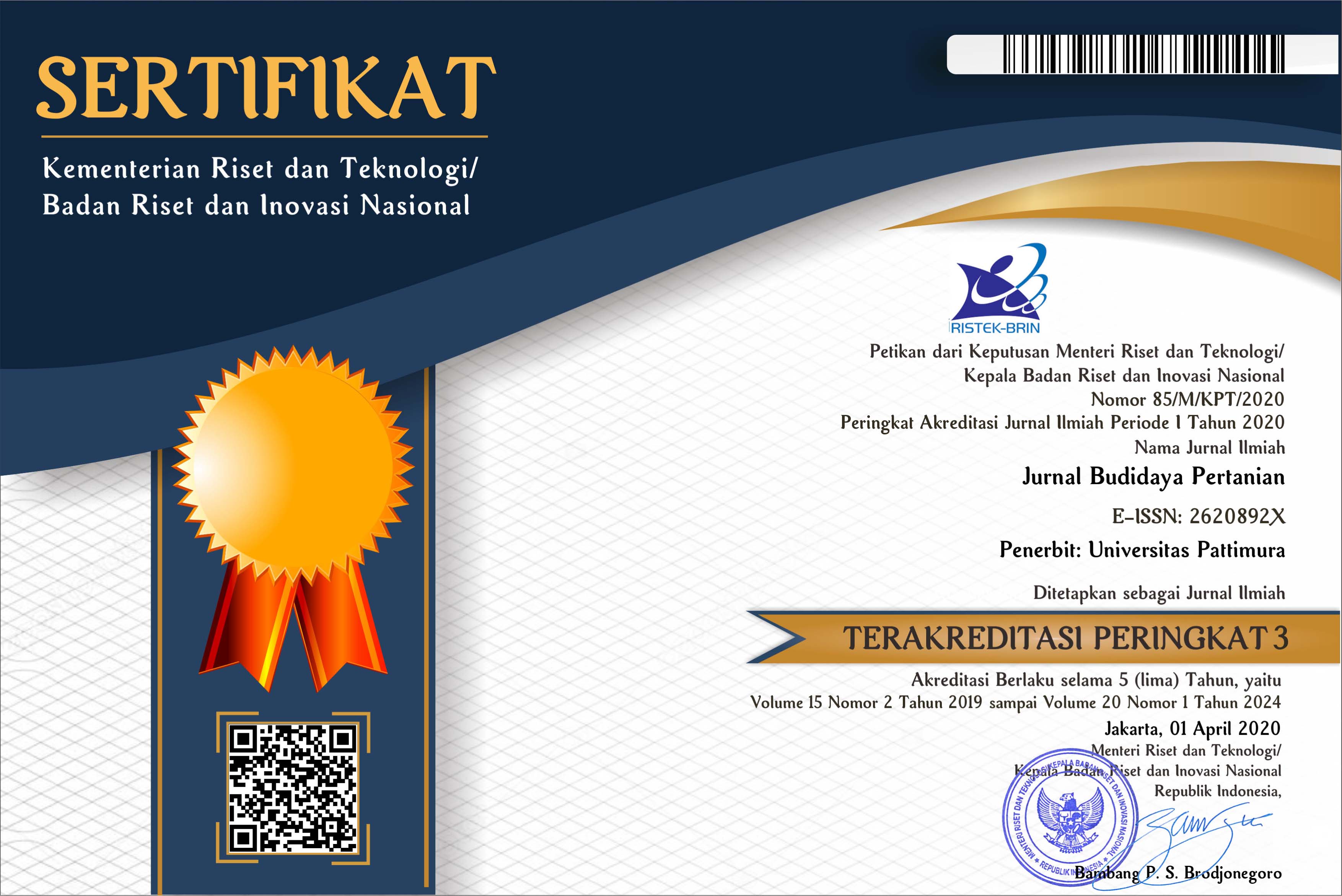Study of Population and Damage Intensity by Necrobia rufipes Pest on Copra
Abstract
The problem of copra damage in storage warehouses by the warehouse pest Nercrobia rufipes is a serious matter because it can reach >10%, is not easy to overcome and causes significant losses. The aim of the study was to obtain the total population of N. rufipes (eggs, larvae, pupae and imago) and the intensity of damage in three storage warehouses in Ambon City. This research was carried out using a survey method at Alam Mas Bersatu, Widya Abadi and UD Sepakat warehouses, from April to June 2018. Samples were taken from several piles blocks and 500 grams of copra sample were taken from each pile from each stratum (upper, middle and lower stratum). The parameters observed were damage symptoms, damage intensity and total population of N. rufipes pest. The results showed that the highest intensity of N. rufipes pest damage was found in the Alam Mas Bersatu warehouse (35.92%) and was classified as moderate damage, followed by those those at UD Sepakat warehouse (21.43%) and Wadya Abadi (7.42%), both classified as light damage. The highest population of N. rufipes was found at the Alam Mas Bersatu warehouse, i.e. larva population (35.29 individuals), pupae (2.33 individuals), imago (6.43 individuals). At UD Sepakat warehouse, the population consisted of larvae (28.83 individuals), pupae (3.83 individuals) and imago (6.33 individuals). The lowest population was at Widya Abadi warehouse, consisted of larvae (5.83 individuals), pupae (0 or not found) and imago (0.5 individuals).
Downloads
References
Budiman, D., Dadang, D., Harahap, I. S. (2019). Keefektifan tiga jenis perangkap seranggga untuk deteksi serangga hama gudang yang menyerang bungkil kopra. Jurnal Entomologi Indonesia, 17(1), 1-10. https://doi.org/10.5994/jei.17.1.1
Dewi, N. M. R., Manueke, J., Rante, C. S., & Meray, E. R. M. (2013). Karakter morfologi Necrobia spp. (Coleoptera; Cleridae) pada beberapa jenis bahan simpanan. PSA. Agroteknologi. Universitas Sam Ratulangi, Manado.
Gabriel, C. E., Manueke, J., Meray, E. R. M., & Ogie, T. (2020). Inventarisasi serangga hama pada kopra di Kecamatan Tobelo, Kabupaten Halmahera Utara. Program. Studi Agroteknologi. Jurusan Hama dan Penyakit. Universitas Sam Ratulangi. Manado
Gonibala, N. (2006). Preferensi Necrobia rufipes de Geer pada beberapa jenis bahan pasca panen. Skripsi. Fakultas Pertanian Universitas Sam Ratulangi, Manado.
Kalshoven, LG. E. (1981). Pests of Crops in Indonesia Revised and Translated by Van Der Laan. P.A. Penerbit PT. Ichtiar Baru Van Houve. Jakarta.
Kartasapoetra, A. G. (1991). Hama hasil tanaman dalam gudang. Penerbit Rineka Cipta. Jakarta. ISBN: 9795182056
Natawigena, (1992). Pestisida dan kegunaannya. Jurusan Proteksi Tanaman. Fakultas Pertanian. Universitas Padjadjaran. Bandung.
Rimbing, J., & Sulthoni, A. (1997). Populasi C. chinensis L dan kerusakan yang ditimbulkannya pada beberapa Jenis kacang-kacangan. Tesis S2 Ilmu Hama Tumbuhan, Universitas Gadjah Mada, Yogyakarta.
Sodiq, M. (1981). Hama di tempat penyimpanan gabah, beras dan jagung. Fakultas Pertanian, Univesitas Pembangunan Nasional Veteran, Surabaya.
Suherman, C., Palenewen, V. V. J., & Mirah, A. D. P. (2016). Analisis keuntungan petani kopra di Kecamatan Tenga, Kabupaten Minahasa Selatan. Agri-Sosio Ekonomi Unsrat, 12 (3A), 135-146. ISSN 1907– 4298
Udha. (2008). Hama-hama tanaman pertanian di Indonesia pada bahan dalam simpanan. Fakultas Pertanian, Universitas Gadjah Mada, Yogyakarta.
Wagiman, F. X. (2014). Hama pascapanen dan pengelolaannya. Penerbit Gadjah Mada University Press, Yogyakarta ISBN: 978-602-386-794-3
Winarno. (2014). Kelapa pohon kehidupan. Penerbit PT. Gramedia Pustaka, Jakarta. ISBN: 978-602-03-1082-4
Copyright (c) 2023 John A Patty, Esther D Masauna, Ponira Ponira

This work is licensed under a Creative Commons Attribution-ShareAlike 4.0 International License.

 Accreditation is valid for 5 years, starting from Volume 15 Issues 2 December 2019 up to Volume 20 Issue 1 June 2024.
Accreditation is valid for 5 years, starting from Volume 15 Issues 2 December 2019 up to Volume 20 Issue 1 June 2024.






